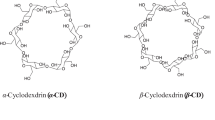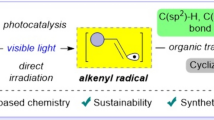Abstract
Interaction of photoinduced electron transfer (PET) based acridinedione dye (ADR 1) with amides like formamide, acetamide and dimethylformamide (DMF) were investigated by fluorescence spectral techniques. A fluorescence enhancement accompanied with a blue shift in the emission maximum was observed on the addition of amides to ADR 1 dye, which possess C6H4(p-OCH3) in the 9th position of the basic acridinedione ring. The extent of fluorescence enhancement and the blue shift in the emission maximum of ADR 1 dye is of the order of DMF > acetamide > formamide. DMF, which is more hydrophobic and less polar, results in a higher extent of fluorescence enhancement and a larger shift in the emission maximum towards the blue region. On the addition of amides, the ADR 1 dye prefers to orient towards a more hydrophobic phase surrounded by more number of amide molecules. The fluorescence enhancement of ADR 1 dye is attributed to the suppression of PET process occurring through space. The influence of the hydrophobic nature and the polarity of the amides on the excited state properties of acridinedione dyes are elucidated by steady-state and time resolved fluorescence measurements.










Similar content being viewed by others
References
Singh S, Chhina S, Sharma VK, Sachev SS (1982) Cationic hydrogenation of benzyl alcohols and arylethylenes using acridane derivatives as hindered NADH model. J Chem Soc Chem Commun 8:453–459
Thiagarajan V, Ramamurthy P, Thirumalai D, Ramakrishnan VT (2005) A novel colorimetric and fluorescent chemosensor for anions involving PET and ICT pathways. Org Lett 7:657–660
Ashokkumar P, Thiagarajan V, Vasanthi S, Ramamurthy P (2009) Triple fluorescence of acridinedione: Locally excited, photoinduced electron transfer promoted charge transfer and anion induced charge transfer states. J Photochem Photobiol A Chem 208:117–124
Indirapriydharshini VK, Karunanithi P, Ramamurthy P (2001) Inclusion of resorcinol based acridinedione dyes in cyclodextrins: fluorescence enhancement. Langmuir 17:4056–4060
Thiagarajan V, Indirapriyadharsini VK, Ramamurthy P (2006) Fencing of photoinduced electron transfer in nonconjugated bichromophoric system by β- cyclodextrin nanocavity. J Incl Phenom Macrocyclic Chemistry 56:309–313
Kumaran R, Ramamurthy P (2006) PET suppression of acridinediones by urea derivatives in water and methanol. J Phys Chem B 110:23783–23789
Kumaran R, Ramamurthy P (2010) Photophysical studies of PET based acridinedionedyes with globular protein: Bovine Serum Albumin (BSA). J Lumin 130:1203–1210
Kumaran R, Varalakshmi T, Padma Malar EJ, Ramamurthy P (in press) Photophysical studies on the interaction of acridinedione dyes with universal protein denaturant:Guanidine hydrochloride. J Fluoresc doi:10.1007/s10895-010-0646-9
Koteeswari R, Ashokkumar P, Ramakrishnan VT, Padma Malar EJ, Ramamurthy P (2010) Unprecedented formation of an N-benzamidobisthiourea derivative and its role in the formation of a new CT state specific towards fluoride ion. Chem Commun 46:3268–3270
Ashokkumar P, Ramakrishnan VT, Ramamurthy P (2009) Specific Ca2+ Fluorescent Sensor: Signaling by Conformationally Induced PET Suppression in a Bichromophoric Acridinedione. Eur J Org Chem 5941–5947
Thiagarajan V, Ramamurthy P (2007) Fluorescent sensing of anions with acridinedione based neutral PET Chemosensor. Spectrochim Acta Part A 67:772–777
de Silva AP, Gunaratne HQN, Gunnlaugsson T, Huxley AJM, McCoy CP, Rademacher JT, Rice TE (1997) Signaling recognition events with fluorescent sensors and switches. Chem Rev 97:1515–1566
Valuer V (2001) Molecular fluorescence principles and applications. Wiley-VCH Verlag GmBH, Veinheim
Rurack K, Resch-Genger U (2002) Rigidization, preorientation and electronic decoupling—the magic triangle for the design of highly efficient fluorescent sensors and switches. Chem Soc Rev 31:116–132
Barthel J, Gores HJ (1994) Solution chemistry, a cutting edge in modern electrochemical technology. In: Mamantov G, Popov AJ (eds) Chemistry of nonaqueous solutions…current progress. VCH, New York
Weissermel K, Arpe HJ (1993) Industrial organic chemistry, 2nd edn. VCJ, Weinheim
Barthel J, Buchner R, Wurm B (2002) The dynamics of liquid formamide, N-methylformamide, N, N-diemthylformamide, and N,N-dimethylacetamide. A dielectric relaxation study. J Mol Liquids 98–99:51–69
Srividya N, Ramamurthy P, Shanmugasundaram P, Ramakrishnan VT (1996) Synthesis, characterisation and electrochemistry of some acridine-1,8- dione dyes. J Org Chem 61:5083–5089
Srividya N, Ramamurthy P, Ramakrishnan VT (1997) Solvent effects on the absorption and fluorescence spectra of some acridinedione dyes: determination of ground and excited state dipole moments. Spectrochim Acta Part A 53:1743–175
Srividya N, Ramamurthy P, Ramakrishnan VT (1998) Photophysical studies of acridine (1, 8) dione dyes; a new class of laser dyes. Spectrochim Acta Part A 54:245–253
Bipp H, Kieczka H (1989) Ullmans encyclopedia of industrial chemistry A12 (Sed). VCH, Verlagsgesellschaft, Weinheim, pp 1–12
Acknowledgements
Financial support by DST-IRHPA and UGC-INNOVATIVE Programme is acknowledged. R.K thanks the UGC for providing the financial assistance.
Author information
Authors and Affiliations
Corresponding author
Electronic Supplementary Material
Below is the link to the electronic supplementary material.
Figure S1
Absorption spectra of ADR 2 dye in the absence and presence of formamide in water. 1) ADR 1 dye alone (1.5 × 10−5 M), 2) formamide 2.5 M, 3) ADR 1 dye + formamide 2.5 M, 4) ADR 1 dye + formamide 5.0 M (JPEG 21 kb)
Figure S2
Emission spectra of ADR 1 dye in the absence and presence of acetamide in water λex378 nm. 1) ADR 1 dye alone (1.5 × 10−5 M), 2) ADR 1 dye + acetamide 2.5 M, 3) ADR 1 dye + acetamide 5.0 M, 4) ADR 1 dye + acetamide 7.5 M, 5) ADR 1 dye + acetamide 10.0 M, 6) ADR 1 dye + acetamide 12.5 M (JPEG 20 kb)
Figure S3
Fluorescence decay of ADR 1 and ADR 2 dyes in water. λex378 nm (JPEG 28 kb)
Rights and permissions
About this article
Cite this article
Kumaran, R., Ramamurthy, P. Photophysical Studies on the Interaction of Formamide and Alkyl Substituted Amides with Photoinduced Electron Transfer (PET) Based Acridinedione Dyes in Water. J Fluoresc 21, 2165–2172 (2011). https://doi.org/10.1007/s10895-011-0918-z
Received:
Accepted:
Published:
Issue Date:
DOI: https://doi.org/10.1007/s10895-011-0918-z




